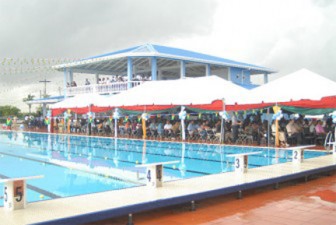Bids are again being sought for a warm-up, warm-down pool for the National Aquatic Centre at Liliendaal, 18 months after the facility opened amid concerns about its cost and planning for it.
An advertisement in yesterday’s Guyana Chronicle listed the engineer’s estimate for the facility at $38.7M. These are placed only in the state newspaper. Interested bidders have up to June 18, 2013 to submit their tenders to the National Procurement and Tender Administration Board at the Ministry of Finance on Urquhart Street and bidding documents can be perused at the Ministry of Sport at Main and Quamina streets. Bids have to be accompanied by a bid security of $750,000 and bidders are urged to ensure that there are site visits and verification of the scope of the works.
For the Olympic standard pool to be a top venue it needed a warm-up/warm down pool from the outset and this had been spoken about since the facility was commissioned in November of 2011.

The aquatic centre was built for $581M which had seen a change of contractor and the charge that this had caused a wasting of money.
In March 2012, Minister of Sport, Dr Frank Anthony in a written response to a question in Parliament by AFC MP Khemraj Ramjattan about the cost of the Aquatic Centre, detailed the figures for consultancies for design and supervision, and construction, which totalled $581,367,932. In a press release the ministry also outlined design and engineering difficulties that plagued the project, necessitating reviews and resulting in a six-month suspension of works at one point.
Geotechnical engineer Charles Ceres later told Stabroek News that the pool could have been built for one-third of the amount that was eventually spent.
In a letter to Stabroek News, Ceres had said that “the most obvious failure of the application of sound engineering principles” is reflected in the design of the aquatic centre.
He had pointed out that the weight of soil removed to create the pool at that location is approximately one and one-half times the weight of the pool itself (unit weight of soil approximately 105lbs/ft3 and unit weight of water of 62.4lbs/ft3). “In spite of the fact that the pool weighs less than the soil displaced, that facility is supported by piles too numerous to count,” he said.
The veteran engineer said the installation of piles is not the optimum solution and interested individuals only have to look at several pump stations, installed by Booker Tate, within the GuySuCo infrastructure network at significantly greater depths than the pool at Liliendaal, none of which are supported or anchored by piles.
Government had committed to adding a 25-metre warm-up pool on site, to cater for international competitions and training for local swimmers.
The disclosure in the National Assembly in March 2012 was the most detailed information yet from the ministry on this project. Anthony said that consultancies for design and supervision, provided by E&A Consultants Inc, Fotcon and Vikab, cost $22,534,500. Construction, meanwhile, was pegged at $558,833,432, with services provided by Kares Engineering Inc ($276,195,151); Myrtha Pools USA ($208,396,407); Guyana Power and Light ($4,249,268); Guyana Water Inc ($3,400,000); R Persid Construction ($20,246,127); Pioneer Construction ($9,796,270); Dipcon Engineering Services ($23,013,350); G Bovell Construction ($3,488,870); as well as liabilities covered by the ministry ($10,037,989).
In a statement accompanying the cost breakdowns, the ministry revealed that Fotcon and Vikab did the original design for the centre, and Kares Engineering was subsequently awarded a $316,394,320 contract for construction, from eight companies that bid for the project. The engineer’s estimate had been $425,127,099. In addition, E&A Consultants Inc was selected from three companies for a $13,363,500 contract to provide supervision services.
Work began in February of 2008, but by March “a number of design issues developed,” the ministry said, adding that a review was done by the technical team and adjustments were made. Nonetheless, the difficulties “persisted” and the ministry said works were suspended between November 19, 2008 and May 18, 2009. When works resumed, engineering problems, however, resurfaced.
According to the ministry, in August 2009, after consultations with Fédération Internationale de Natation (FINA)—the international governing body of swimming—Myrtha Pools was invited to do a presentation and it subsequently submitted a pre-engineered pool for consideration to project engineer Walter Willis.
It added that an extensive review was done by a team headed by Willis and it recommended that the scope of works for Kares be reduced, while Myrtha Pools be contracted to design and build a pre-engineered pool (50m x 25m x 2m).
Cabinet, in November the same year, approved the proposal and the company was contracted for $241,246,407 while the scope of works for Kares was reduced to $214,455,290. Myrtha, contracted on December 1, 2009, completed its contract in August 2010, the same month that Kares completed its work.
However, additional works were required. “Despite the pool being functional, there was need for additional work on the pool site,” the ministry said, citing the need for installation of concrete drains, seating tiers on the grass mound, paved parking, security lights and a guard hut. It added that four companies—R Persid Construction, Pioneer Construction, Dipcon Engineering Services, G Bovell Construction—were hired after public tendering.
Since its opening, the pool has been at the centre of contention over access to swimmers and the extent of its use in competitions.





